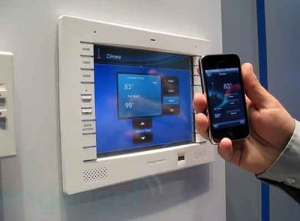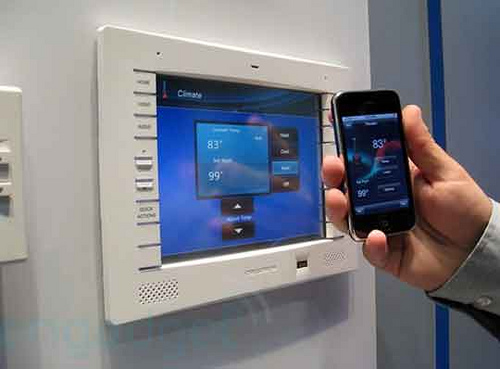
Want your home to work with you to offer better comfort levels, greater convenience and a much-welcome reduction in your utility bills? Then investing in smart control technology could be a wise choice
Smart technology can stretch into pretty much every aspect of home life. You’re probably already familiar with the headline-grabbing systems, such as multi-room audio and video, cinema-style spaces and ultra-fast networks teamed with breakneck broadband. But home automation doesn’t have to be all glitz and glamour. In fact, it’s the more nuts and bolts tech that can make the biggest difference to how your house works for you. Gadgets offering central or remote control of heating, lighting, energy monitoring and security systems may not be ‘show-off-to-your-friends’ additions, but incorporating them into your project will bring convenience, greater functionality and even the potential to save energy and money. So how do you get a smarter home?
Taking command
Control is at the heart of home automation. Whether you’re setting up for clever heating, lighting, security or a combination of all three, the way in which you interact with and operate the system will be crucial to its success.
Wall-mounting touchscreens in every room is a standard choice for hard-wired smart systems. The interface will give access to key functions for that space, such as lighting and temperature management, and may offer whole-house access, too. Fuelled by the tablet phenomenon, however, wireless controls are growing in popularity. These units, usually kept in a much-used space such as the living room or kitchen, allow you to operate your entire home automation package from the comfort of your armchair. They’re especially popular for DIY installations, or on retrofit projects where running new cabling would prove expensive. Many new smart systems, whether they’re hardwired or not, will accommodate wifi controls and equipment.
Some installers offer a variety of control systems, while others focus on a single provider. Popular brands include Crestron, Home Automation Inc, Lutron and X10 – all of these companies manufacture products to cater for different requirements and budgets. Many of their systems will also allow remote internet or cloud-based access from your desktop, laptop, iPad or tablet, and even smartphones.
The most common setups installed are for lighting and AV, some customers prefer to integrate everything into one system, often with an iPad as the principal control device. Others keep lighting, AV, heating and security separate, mixing and matching products or manufacturers to suit their requirements. From our perspective, the goal is to keep the interface as simple as possible – the clever, complicated parts should go unnoticed in the background.
Using an iPad or iPhone app as your control also allows you to easily come up with new schemes, such as lighting moods, and save them for future use. What’s more, it’s easier to maintain – for example, we can reset the system to its original state if you change or delete a scheme by accident. Installers such as Tillman Domotics offer a seven day, 9am to 5pm support service, and make use of internet feedback from your control rack to help diagnose and resolve issues or update software.
Some systems are even able track your lifestyle and usage patterns, and relay that data so that you can make well-informed decisions about whether to change schemes or settings. Others will tailor their automated functions to the weather, and many will offer preset modes such as ‘in’, ‘out’, ‘holiday’ and ‘eco’.
Climate control
One of the biggest issues self builders and renovators face is how to heat (and cool) their homes efficiently. The choices you make at the planning stages of a smart system will have a big impact on how your house works for you in terms of comfort levels, energy usage and utility costs – and the more control you have, the better the results will be.
A basic smart heating system might feature room sensors or digital thermostatic valves at every radiator, feeding information back to a central control unit. From here you can set the usual weekly or daily heating programs. Some controls offer the potential to save seasonal programs or add functions such as holiday modes. You’ll find plenty of DIY options on the market, and if you opt for wireless sensors or radiator valves, you can take these with you should you choose to move home in the future.
A zoned system – giving you both direct and remote control over individual rooms -is the next step up. Underfloor heating is a popular choice for such setups. Each UFH zone can have its own loop connected to a manifold, so spaces will only be actively warmed when the related thermostat calls for heat. A bathroom might only be heated for an hour in the morning and evening, for example, rather than for the entire day. Your central controller will allow you to quickly override the program if required.
At the top end, you’ll be combining heating, ventilation and air conditioning (if required) into a single system with in-room sensors, touchscreens and remote control pads. The setup will respond to your lifestyle, adjust to outdoor temperatures and even automatically regulate humidity -which will help minimise the risk of damp or similar issues taking hold. Renewables such as solar thermal, heat pumps and mechanical ventilation heat recovery will be easy to integrate and manage effectively, while solar control measures (automated blinds, for example) might also be hooked up. You can expect feedback on your usage patterns, too – either at your control point or via the internet – to help you fine-tune the system and reduce bills.
Author Bio:
Guest post by Kashif Raza. Presently working for Aqua Protection which provide a roof coating service for all types of roofs with concrete and clay tiles.


